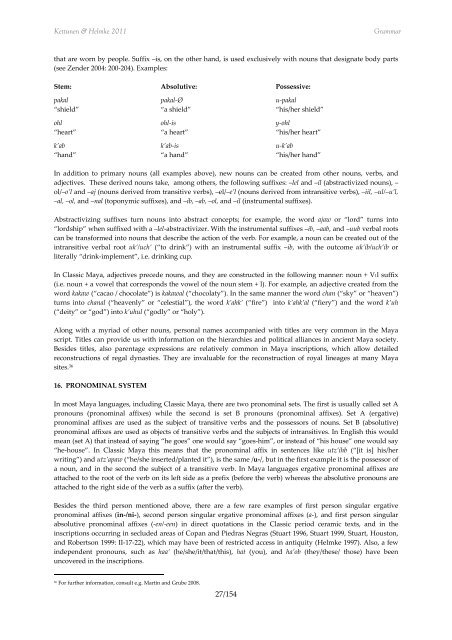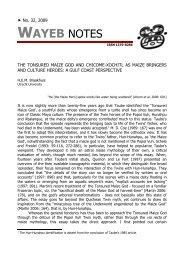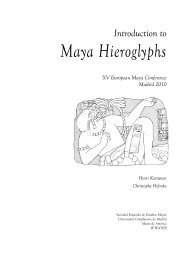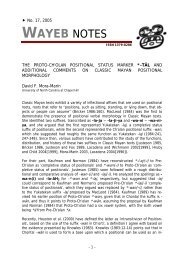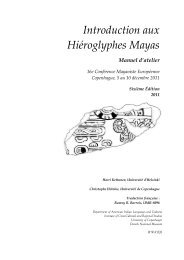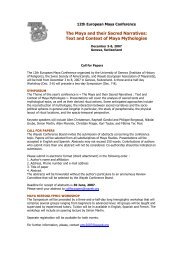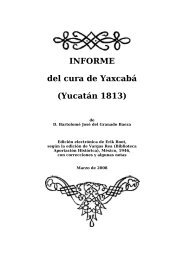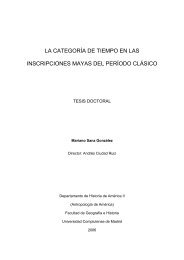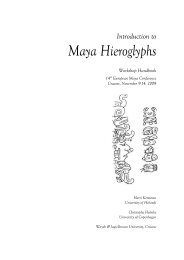Introduction to Maya Hieroglyphs - Wayeb
Introduction to Maya Hieroglyphs - Wayeb
Introduction to Maya Hieroglyphs - Wayeb
You also want an ePaper? Increase the reach of your titles
YUMPU automatically turns print PDFs into web optimized ePapers that Google loves.
Kettunen & Helmke 2011<br />
Grammar<br />
that are worn by people. Suffix –is, on the other hand, is used exclusively with nouns that designate body parts<br />
(see Zender 2004: 200-204). Examples:<br />
Stem: Absolutive: Possessive:<br />
pakal pakal-Ø u-pakal<br />
“shield” “a shield” “his/her shield”<br />
ohl ohl-is y-ohl<br />
“heart” “a heart” “his/her heart”<br />
k’ab k’ab-is u-k’ab<br />
“hand” “a hand” “his/her hand”<br />
In addition <strong>to</strong> primary nouns (all examples above), new nouns can be created from other nouns, verbs, and<br />
adjectives. These derived nouns take, among others, the following suffixes: –lel and –il (abstractivized nouns), –<br />
ol/–o’l and –aj (nouns derived from transitive verbs), –el/–e’l (nouns derived from intransitive verbs), –iil, –ul/–u’l,<br />
–al, –ol, and –nal (<strong>to</strong>ponymic suffixes), and –ib, –ab, –ol, and –il (instrumental suffixes).<br />
Abstractivizing suffixes turn nouns in<strong>to</strong> abstract concepts; for example, the word ajaw or “lord” turns in<strong>to</strong><br />
“lordship” when suffixed with a –lel-abstractivizer. With the instrumental suffixes –ib, –aab, and –uub verbal roots<br />
can be transformed in<strong>to</strong> nouns that describe the action of the verb. For example, a noun can be created out of the<br />
intransitive verbal root uk’/uch’ (“<strong>to</strong> drink”) with an instrumental suffix –ib, with the outcome uk’ib/uch’ib or<br />
literally “drink-implement”, i.e. drinking cup.<br />
In Classic <strong>Maya</strong>, adjectives precede nouns, and they are constructed in the following manner: noun + V1l suffix<br />
(i.e. noun + a vowel that corresponds the vowel of the noun stem + l). For example, an adjective created from the<br />
word kakaw (“cacao / chocolate”) is kakawal (“chocolaty”). In the same manner the word chan (“sky” or “heaven”)<br />
turns in<strong>to</strong> chanal (“heavenly” or “celestial”), the word k’ahk’ (“fire”) in<strong>to</strong> k’ahk’al (“fiery”) and the word k’uh<br />
(“deity” or “god”) in<strong>to</strong> k’uhul (“godly” or “holy”).<br />
Along with a myriad of other nouns, personal names accompanied with titles are very common in the <strong>Maya</strong><br />
script. Titles can provide us with information on the hierarchies and political alliances in ancient <strong>Maya</strong> society.<br />
Besides titles, also parentage expressions are relatively common in <strong>Maya</strong> inscriptions, which allow detailed<br />
reconstructions of regal dynasties. They are invaluable for the reconstruction of royal lineages at many <strong>Maya</strong><br />
sites. 36<br />
16. PRONOMINAL SYSTEM<br />
In most <strong>Maya</strong> languages, including Classic <strong>Maya</strong>, there are two pronominal sets. The first is usually called set A<br />
pronouns (pronominal affixes) while the second is set B pronouns (pronominal affixes). Set A (ergative)<br />
pronominal affixes are used as the subject of transitive verbs and the possessors of nouns. Set B (absolutive)<br />
pronominal affixes are used as objects of transitive verbs and the subjects of intransitives. In English this would<br />
mean (set A) that instead of saying “he goes” one would say “goes-him”, or instead of “his house” one would say<br />
“he-house”. In Classic <strong>Maya</strong> this means that the pronominal affix in sentences like utz’ihb (“[it is] his/her<br />
writing”) and utz’apaw (“he/she inserted/planted it”), is the same /u-/, but in the first example it is the possessor of<br />
a noun, and in the second the subject of a transitive verb. In <strong>Maya</strong> languages ergative pronominal affixes are<br />
attached <strong>to</strong> the root of the verb on its left side as a prefix (before the verb) whereas the absolutive pronouns are<br />
attached <strong>to</strong> the right side of the verb as a suffix (after the verb).<br />
Besides the third person mentioned above, there are a few rare examples of first person singular ergative<br />
pronominal affixes (in-/ni-), second person singular ergative pronominal affixes (a-), and first person singular<br />
absolutive pronominal affixes (-en/-een) in direct quotations in the Classic period ceramic texts, and in the<br />
inscriptions occurring in secluded areas of Copan and Piedras Negras (Stuart 1996, Stuart 1999, Stuart, Hous<strong>to</strong>n,<br />
and Robertson 1999: II-17-22), which may have been of restricted access in antiquity (Helmke 1997). Also, a few<br />
independent pronouns, such as haa’ (he/she/it/that/this), hat (you), and ha’ob (they/these/ those) have been<br />
uncovered in the inscriptions.<br />
36<br />
For further information, consult e.g. Martin and Grube 2008.<br />
27/154


